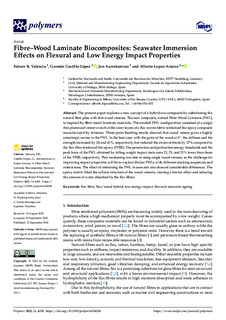Título
Fibre-Wood Laminate Biocomposites: Seawater Immersion Effects on Flexural and Low Energy Impact PropertiesAutor-a
Otras instituciones
Universität der Bundeswehr MünchenUniversidad de Málaga
Universidad del País Vasco/Euskal Herriko Unibertsitatea (UPV/EHU)
Versión
Version publicada
Derechos
© 2022 The AuthorsAcceso
Acceso abiertoVersión del editor
https://doi.org/10.3390/polym14194038Publicado en
Polymers Vol. 14. N. 19. Artículo 4038Editor
MDPIPalabras clave
flax fibre
flax/wood hybrid
low energy impact
flexural ... [+]
flax/wood hybrid
low energy impact
flexural ... [+]
flax fibre
flax/wood hybrid
low energy impact
flexural
seawater ageing [-]
flax/wood hybrid
low energy impact
flexural
seawater ageing [-]
Resumen
The present paper explores a new concept of a hybrid eco-composite by substituting the natural fibre plies with thin wood veneers. The new composite, named Fibre–Wood Laminate (FWL), is inspired by fi ... [+]
The present paper explores a new concept of a hybrid eco-composite by substituting the natural fibre plies with thin wood veneers. The new composite, named Fibre–Wood Laminate (FWL), is inspired by fibre–metal laminate materials. The studied FWL configuration consisted of a single thin pinewood veneer at each of the outer layers of a flax woven fabric reinforced bio-epoxy composite manufactured by infusion. Three-point bending results showed that wood veneer gives a highly anisotropic nature to the FWL. In the best case, with the grain of the wood at 0°, the stiffness and the strength increased by 28 and 41%, respectively, but reduced the strain-at-break by 27% compared to the flax fibre reinforced bio-epoxy (FFRB). The penetration and perforation energy thresholds and the peak force of the FWL obtained by falling weight impact tests were 32, 29, and 31% lower than those of the FFRB, respectively. This weakening was due to using single wood veneers, so the challenge for improving impact properties will be to explore thicker FWLs with different stacking sequences and orientations. The effect of immersing the FWL in seawater also showed considerable differences. The epoxy matrix filled the cellular structure of the wood veneers, creating a barrier effect and reducing the amount of water absorbed by the flax fibres. [-]
Sponsorship
Gobierno Vasco-Eusko JaurlaritzaID Proyecto
info:eu-repo/grantAgreement/GV/Ikertalde Convocatoria 2022-2025/IT1613-22/CAPV/Colecciones
- Artículos - Ingeniería [743]
El ítem tiene asociados los siguientes ficheros de licencia:






















